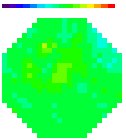| The following are
NOT
included in the NeuroPDA or NeuroCCD
Systems, but are necessary.
Microscope
In general, large numerical apertures
should be used to maximize light intensity. However, when
the signals of interest come from multiple focal planes, a
smaller numerical aperture may be required. The interface
between the microscope and all three cameras is a C-mount
connector.
Light Sources:
In most cases the brighter the light
source the better. Our cameras are excellent at detecting
small changes on a large resting background.
LEDs
Progress in LED technology in the last few years, makes LEDs the preferred light source for many experiments.
They are available in many different wavelengths. Their light intensity is stable and much higher than that of a Xenon lamp (up to X10 or so) and
their lifetime much longer. Moreover, light intensity is linearly related to the current through the LED and can be adjusted to the experiment.
On/Off is instantanuously controlled by a voltage pulse,
thus avoiding the need of a shutter (see below). We recommend
Cairn Research Ltd's
as well as Prizmatix's LEDs.
Microscope Light Source
For absorption
and population fluorescence signals (where the light levels
are high) a tungsten-halogen source is often used. The microscope
tungsten-halogen lamp housing will often be satisfactory.
However, the DC power supply supplied by the microscope manufacturer
may not be optimal and a well-stabilized DC supply may be
essential. We recommend the VS-20ML power supply by Astron
(9 Autry, Irvine, CA 92618, (949) 458-7277 l (949) 458-0826). For single cell fluorescence (where the light levels
are low) we recommend an arc lamp. Cairn
Research Ltd
(Graveney Road, Faversham, Faversham, Kent, ME13 8UP, U.K. tel:
+44(0)1795 590140) is a highly recommended supplier of Xenon arc lamps
and power supplies. Used with their monochromator the 75W Xenon is
brighter than the 150W. The opposite will be true without the
monochromator. Their light source has a built in shutter (see below).
Shutter
A shutter which can be driven by a
5-volt pulse should be available; shutter opens at 5 volts,
closes at 0 volts.
In addition to reducing bleaching and photo toxicity, using a shutter eliminates a camera drift
(see
http://www.redshirtimaging.com/support/Shutter.html).
We use shutter drivers and shutters
from Vincent Associates. Choose a shutter opening that is
larger than the diameter of the incident light beam. We use
a VS35S1ZM0R1-with heat sink shutter (designed to withstand
high intensity light and high temperatures) and a VCMD1 Shutter
driver. If the shutter is directly attached to the microscope, its opening is likely to
cause a damped vibrational noise that lasts for about a second. This effect can
be reduced by mounting the shutter independently of the microscope (see
http://www.redshirtimaging.com/support/Shutter.html).
Stimulator
The software generates a signal to
the stimulator with a rising edge to 5 volts.
Splitters
For recording emission from 2 wavelengths
simultaneously we have used and are supporting the
Optical Insights, LLC
Dual-View splitter. A similar solution for doing emission ratio
imaging, the OptoSplit-II is offered by
Cairn Research. With these optical devices, each of the two
images created by the splitter is recorded simultaneously on half
of the camera chip. When using a low spacial resolution
camera (e.g. NeuroCCD-SMQ) for recording very fast transients, a better
solution is to use a dichroic mirror as a beam splitter and record
simultaneously with two cameras.
Filters
The specific filters needed for fluorescence measurements - excitation,
emission and dichroic mirrors - are dependent on the dyes used for the
measurements. We therefore include filters only with Macroscope II.
Excitation filters could be obtained from
Chroma Technology Corp . For emission, we find
Schott Glass filters, very good.
Camera Stands
Users who are not using a microscope, need a stabilized optical arrangement
to align the camera, via a Macroscope or other lens, to look at the preparation. We have helped several
laboratories to put together such a stand, using components from
Linos . A list of parts is available from us.
Vibration-Isolation
Optical recordings are very sensitive
to vibration. Most disruption is caused by vibrations in the
horizontal plane. A vibration isolation system, air table
or table supported by inner tubes is required. In situations
where the vibrational noise is not severe, a platform made
from an optical tabletop mounted on airfilled rubber
tubes (obtained from Newport: isolator, air cushion, #5274)
is adequate. For more severe vibration problems, Minus
K Technology sells vibration isolation tables with
very low resonant frequencies.
Secondary Camera (for NeuroPDA)
Because of the relatively low spatial
resolution of the NeuroPDA system, it is useful to relate
the optical signals to the preparation by obtaining a higher
resolution image. A high resolution camera (placed either
in the usual position of the array or a second view port)
can be used to produce a TIFF or a BMP file of the image of
the preparation. The NeuroPlex software can import these files
and overlay the images with the pseudo-colored optical data.
A Dage-MTI CCD-300-RC (CCD Camera with RC300 Control) (Michigan
City, IN) with a 3045 Integral Technologies FlashBus MV Pro
Frame Grabber from I-Cube (Crofton, MD) has been successfully
used for this function.
Computer Monitor
We strongly recommend purchasing a
high resolution monitor (1600x1280 or greater) because it
is helpful to be able to visualize as much data as possible,
and the software display is designed for a very high resolution
monitor. For those who would like a NeuroPlex display larger
than that provided by a 1600x1280 21 inch monitor, two monitors
can be used simultaneously A video card that supports two
monitors is the Matrox, G200MULTI-MONITOR (DUAL); part number
G2/DUALP-PL (for PCI slot).(contact Brian
Salzberg and AnaLia
Obaid).
Room Lighting
The outputs of ordinary room lights
often introduce 60 or 120 cycles into the optical recordings.
DC powered lights should be available for experiments.
|



